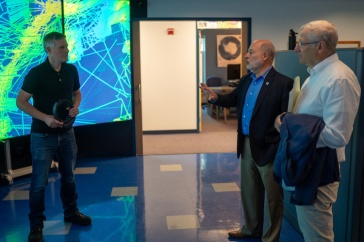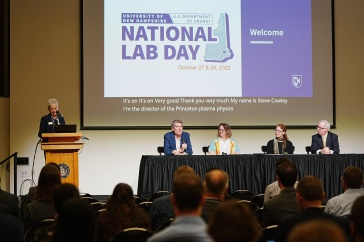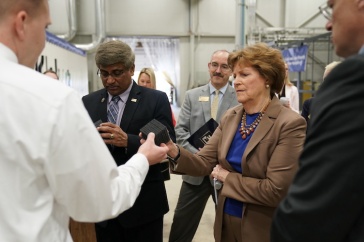
UNH and French company Exail, a global innovator in the field of maritime autonomy and robotics, celebrated the opening of the Maritime Autonomy Innovation Hub at UNH at an event Saturday, July 15. The partnership will bring Exail’s production of its DriX, an uncrewed surface vessel designed for ocean mapping and exploration, to UNH, enhancing collaboration between Exail and UNH’s Center for Coastal and Ocean Mapping (CCOM).

“This exciting collaboration will not only be good for Exail and UNH students and researchers but also good for New Hampshire and the nation,” said CCOM director Larry Mayer. “We anticipate that it is just the start of bringing many of our other industrial partners and government colleagues to the state as we create a local engine for the new blue economy.”
Mayer joined UNH President Jim Dean, U.S. Sen. Maggie Hassan, NOAA Assistant Administrator Nicole LeBoeuf and Marine Slinge, Exail president for North America civil and space, in brief remarks at the event at UNH’s Judd Gregg Marine Research Complex in New Castle.
“We’ve been working together with UNH for the past six years pioneering uncrewed technologies, and we are now capitalizing on our common achievements with the opening of this new innovation hub,” Slingue said. “We’re very proud and excited to take this next step in our U.S. adventure, and we would like to thank UNH, CCOM and NOAA for their great support and their leadership and vision on the use of uncrewed technologies that took us where we are today. We look forward to our continuous partnership with them and all the great work we achieve together to keep advancing maritime autonomy in the U.S.”
Sen. Hassan reflected on the importance of the Maritime Autonomy Innovation Hub to Granite Staters. “Exail and UNH are cementing their status as true pioneers in the field of maritime automation,” she said. “The opening of this center is a win for New Hampshire – and is a vital investment in our future. When people want the best in maritime autonomous vessels, they are now going to look to New Hampshire.”
President Dean noted that this partnership exemplifies UNH's "open for business" mindset and the value created by university collaborations with the business community. “This hub will pave the way for other co-location opportunities as UNH presses forward with our plans for The Edge innovation district,” he said.
Following remarks, the 25-foot-long, 1.6-ton bright red DriX took center stage as it made its way from the UNH pier into the mouth of the Piscataqua River for a brief demonstration. There, it showcased its seafloor mapping capacity and nimble maneuverability, even as it dodged boats and buoys. While one presentation screen showed drone footage of the DriX’s voyage, Exail technicians detailed its ocean mapping and autonomy capacities in real time on additional screens.
The Maritime Autonomy Innovation Hub will be located at UNH’s John Olson Advanced Manufacturing Center.
-
Written By:
Beth Potier | UNH Marketing | beth.potier@unh.edu | 2-1566



















































